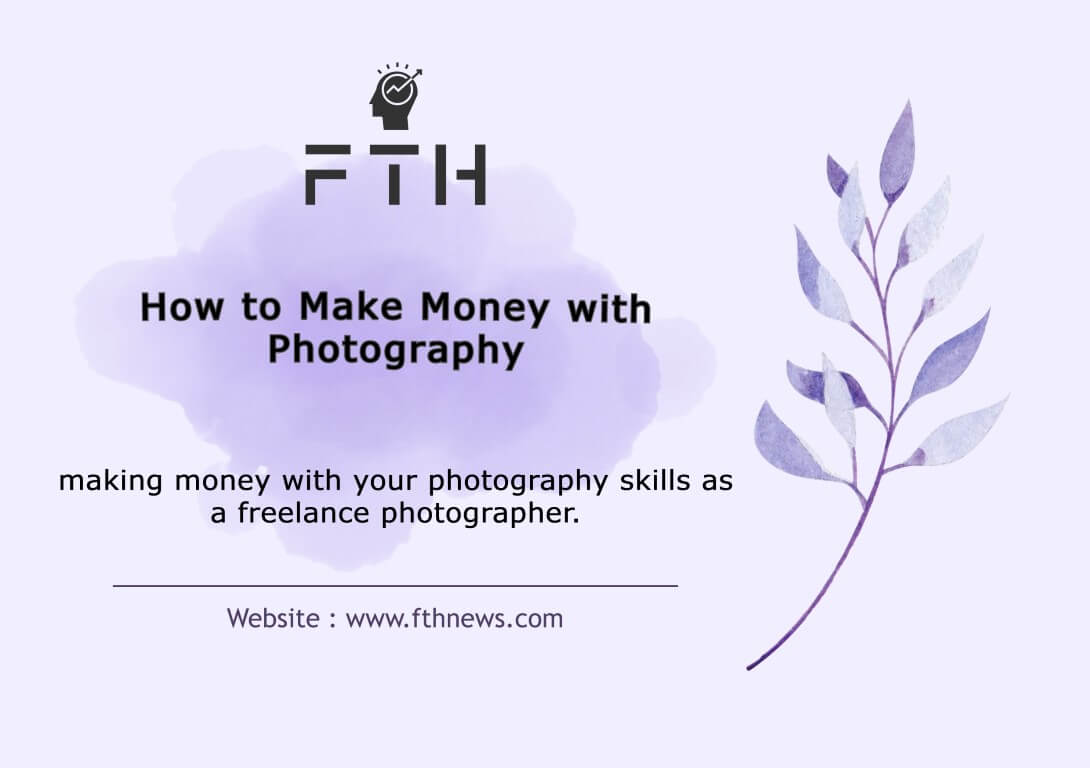
How to Make Money with Photography: A Guide for Freelancers
How to Make Money with Photography ? Are you an aspiring photographer still learning or stuck in a job that lacks passion? If you’re contemplating a career in photography, then venturing into the world of freelance photography might be the perfect path for you.
Many photographers have chosen the freelance route and crafted successful, fulfilling careers. In this digital age, photography serves a diverse array of purposes for a wide range of individuals and businesses. Consequently, the demand for professional photographers is on the rise, presenting numerous opportunities across photography genres, from Tibetan culture to baby photography, and from capturing the moments of newlyweds to much more.
What Is a Freelance Photographer?
Freelance photography falls under the realm of self-employment. In a time where the costs of office spaces, mortgages, and rentals are on the rise, freelance careers have surged in popularity. What sets freelance photography apart is its independence from the need to invest in office spaces, mortgages, or rental expenses. A freelance photographer can enter the job market with minimal capital investment and the freedom to initiate their work without these traditional overheads.
Turning Your Passion for Photography into a Profitable Venture: A Guide to Becoming a Freelance Photographer
How to Make Money with Photography And Making a living from photography is a dream for many. Converting your passion for photography into a viable career can seem daunting, especially for beginners. However, with diligent research, unwavering passion, and a well-defined plan, the path to becoming a freelance photographer becomes not only possible but also rewarding.
How to Make Money with Photography to Begin Your Journey as a Freelance Photographer?
One of the initial steps to embark on a career as a freelance photographer is meticulous planning. A well-structured approach is essential to facilitate your professional growth. As you set out on How to Make Money with Photography journey, consider creating a comprehensive to-do list that goes beyond mere aspirations. Here are some key aspects to include in your initial plan:
Prepare a Work Plan: Define your objectives, set goals, and establish a clear roadmap for your photography business.
Identify Your Photography Niche: Determine your target market or specialization, whether it’s portrait photography, event photography, or any other niche that aligns with your interests and skills.
Invest in the Right Photography Equipment and Software: Quality gear is essential for producing outstanding photographs. Research and invest wisely in the equipment and software that suit your chosen niche.
Pricing Strategy: Decide on pricing models for your photography services. Consider your experience, market rates, and the value you bring to your clients.
Marketing Your Work: Develop a marketing strategy to showcase your work and reach potential clients. Utilize online platforms, social media, and other marketing channels to promote your photography services.
Build and Showcase Your Portfolio: Assemble a portfolio that highlights your best work. A compelling portfolio is your calling card in the photography industry.
While these steps are pivotal in your journey to becoming a professional freelance photographer, remember that self-belief and confidence in your abilities are equally essential.
Starting any new business can be intimidating, and there’s no one-size-fits-all guide. However, with self-investment, courage, confidence, and a well-thought-out business plan, your photography venture can thrive and bring your dreams to life.
Key Steps to Launch Your Freelance Photography Career
If you’re looking to turn your photography passion into a thriving freelance business, follow these six critical steps. These steps essentially form your business plan—a roadmap for your entrepreneurial journey. Your business plan doesn’t need to be overly formal, but it should serve as a reference to keep you on track and focused.
1. Define Your Business:
- Start by outlining a general description of your photography business. Determine the type of photography that resonates with your skills and interests, identify your target market, and discover what makes you unique. Specify your goals in clear, actionable terms.
2. Articulate Your Vision:
- Your business plan should include both your long-term vision and short-term goals. Be meticulous and organized during the planning process. The more detailed and focused your plan, the easier it becomes to translate your passion into action.
3. Legal Structure and Branding:
- Consider the legal structure of your business. Decide on a name and brand identity that best represents your work. Investigate the necessary licenses and permits to operate legally in your area.
By incorporating these steps into your business plan, you’ll set a solid foundation for your freelance photography career. This plan will act as your guide, helping you stay organized and motivated as you transform your passion into a lucrative venture.
Exploring Your Passion in Freelance Photography
For new freelancers entering the world of photography, the array of options can be overwhelming. Each field of freelance photography offers unique opportunities and requires different skills. Let’s delve into some of these specializations to help you find your passion:
Social Media Photography:
Ideal for photographers looking to master Instagram or Facebook. Businesses and influencer seek high-quality, engaging photos to grow their online presence. The demand for social media photography is consistently high.
Family and Portrait Photography:
A perennial favorite among freelance photographers. Families are in a constant state of growth and change, making capturing these cherished moments a rewarding pursuit.
Event Photography:
Encompasses weddings, parties, concerts, and more. Event planners frequently seek freelance photographers to immortalize these special occasions.
Photojournalism:
A unique blend of art, journalism, and photography. Typically, this field focuses on news, documentation, international events, and street photography.
Specialized Photography Styles:
The world of freelance photography knows no bounds. You can explore various niches, including food, travel, wildlife, fashion, and much more.
Each of these fields has its own appeal and potential for growth. To discover your true passion in the freelance photography business, consider experimenting with different types to find the one that resonates most with you. Remember, your passion will fuel your journey and drive your success.
Discover and Invest in Photography Equipment
When transitioning to a professional freelance photographer, selecting the right equipment is pivotal. Conduct thorough research to identify the best products and gear that align with your preferences. The market offers a wide range of brands, prices, and equipment. However, remember this golden rule: “The artist, not the tool, creates the result.”
In other words, while quality equipment is beneficial, your skills in operating the camera, lighting, posing, and software are paramount. Invest in training to enhance your proficiency in these areas. This investment in knowledge and skill development often yields better results than expensive gear.
Pricing Your Services: How to Make Money with Photography
Determining how to price your photography services can be a delicate balance. One approach is to create packages that specify the number of photos and the extent of editing and Photoshop work included. Be realistic about the time required to complete each shoot.
Here’s a crucial piece of advice: Don’t undervalue your work, especially as you establish yourself as a professional photographer. While it’s common to do some unpaid or low-paid shoots to build your portfolio initially, it’s important to have confidence in your abilities as you progress in your career. Your skills and experience deserve fair compensation. It may take time, but it’s a crucial step towards making a sustainable income as a professional photographer.
Building Your Resume and Portfolio: How to Make Money with Photography
Developing your resume and portfolio is not only an essential part of your business plan but also a critical aspect of establishing your brand as a freelance photographer. These elements play a significant role in marketing and attracting new clients.
As you gain experience and capture more photographs, emphasize your strengths and what sets you apart from other photographers. Your resume and portfolio are your most powerful tools for achieving these objectives.
Kickstart Your Freelance Photography Marketing
Once you’ve established a basic profile and resume, it’s time to showcase your photography skills and talents. Update your social media profiles and website with images that reflect your capabilities.
In the early stages of your business, How to Make Money with Photography it’s vital to attract as many clients as possible. Use various methods, including email, phone calls, and more, to connect with potential clients. Don’t hesitate to reach out to those who might be interested in your services.
Marketing is a powerful tool for transforming your freelance photography business into a recognized brand and attracting new clients. When you reach the marketing stage, develop a strategic plan and be patient while your brand grows. Consistency and enhancing your online presence are key to success.
Advantages of Choosing Freelance Photography
The decision to pursue freelance photography comes with several noteworthy advantages. Among them, the most significant is the liberation of time and place. As a freelance photographer, you have the flexibility to operate in any city or country, and project timelines are in your control.
Additionally, freelance photography doesn’t necessitate substantial capital outlay for equipment or workspace rentals. This cost-efficiency can be particularly advantageous as you kick start your journey in the job market, allowing you to commence your career with a minimal financial burden.
Selecting the Right Photography Equipment: how to make money with photography
Your choice of photography equipment can significantly impact the quality of your work as a freelance photographer. Here are the key components to consider when building your photography kit:
1. Camera Body:
The primary camera body should be robust and durable. Look for a body made of magnesium alloy to withstand daily use. Ensure it has two memory card slots and a long-lasting battery, as freelancers often take hundreds of photos in various locations. Opt for a brand with a variety of compatible lenses. If you travel frequently, choose a globally supported camera for easy servicing and replacements in case of issues.
2. Backup Camera Body:
Every professional photographer should have a backup camera in case the primary one malfunctions. Ideally, your backup camera should be from the same brand as the main one, but it doesn’t need to be as expensive or advanced. Consider diversifying your accessories, such as using a smaller sensor as a backup if your main camera is full-frame. This offers flexibility, especially when using different lenses.
3. Wide Lens:
A wide lens with a focal length range of 24-70mm is essential for versatility in various shooting scenarios, including indoor, landscape, and portrait photography. If your budget allows, invest in a high-quality lens with a wider aperture (e.g., f/2.8) for better depth of field and low-light performance.
4. Telephoto Lens:
A telephoto lens with a focal length starting at 70 mm is indispensable. The 70-200 mm focal range is a versatile choice. Opt for a lens with image stabilization, especially if your camera body lacks this feature. Investing in an f/2.8 telephoto lens offers excellent value for money.
5. Lightweight Tripod:
As a freelance photographer who travels frequently, a compact, lightweight tripod that fits alongside your camera bag is invaluable. Consider its height adjustment and stability. Look for a tripod with independently adjustable legs and a swiveling head for maximum flexibility.
6. Battery, Charger, and Memory Cards:
These are essential tools for your work. Always carry spare charged batteries, a charger, and extra memory cards. Don’t forget to have a backup pack on hand in case of emergencies. Ensure your memory cards are UHS-II compatible for optimal performance with newer cameras.
7. Camera Bag or Case:
Choose a camera bag that suits your needs and is easy to carry. Consider its size, whether it fits in overhead bins, and if it accommodates a laptop and a tripod. For frequent travelers, opt for a bag with wheels for ease of movement.
8. Laptop or iPad Pro:
Freelance photographers often edit on the go, so having a reliable laptop or iPad Pro is crucial. Ensure you have the necessary chargers, memory card readers, and cloud storage for backup to protect your valuable work from accidental deletion or loss.
By carefully selecting your equipment, you’ll be better prepared to handle the demands of freelance photography and produce exceptional results.
Effectively Sharing: how to make money with photography
Being a freelance photographer isn’t just about taking great photos; it’s also about marketing your work and building your brand. There are several ways to showcase your unique style and portfolio to attract clients. Here are some strategies to consider:
1. Social Media Presence:
Social media is a vital tool for your business. Establish a strong presence on platforms like Twitter, TikTok, and Instagram. Engage with potential clients and use relevant tags and hashtags to gain exposure. Over time, you’ll build a network and become known within the industry. Social media is a powerful way to reach your audience.
2. Utilize LinkedIn:
If you don’t already have a LinkedIn profile, create one. Sharing your work on LinkedIn allows you to connect with professionals who hold marketing budgets. Be consistent and active on this platform. Interact with clients and your audience to gain visibility. When you are a regular presence, clients are more likely to reach out to you directly.
3. YouTube Marketing:
YouTube is the second-largest online search engine after Google. If you’re comfortable in front of the camera, consider creating video content. Share behind-the-scenes processes, create summary work reports, and market your freelance photography business regularly on YouTube. Over time, you can establish yourself as a leading YouTuber in your niche, making it easier for clients to discover your services.
4. Professional Portfolio Website:
While social media is important for exposure, a dedicated website provides direct control. Use platforms like Aminus3 or WordPress to quickly create an impressive website showcasing your portfolio. Include a professional profile picture and a brief bio. Make it easy for potential clients to reach you by listing your email address on the site.
5. Word of Mouth Marketing:
Professionalism and reliability are paramount for freelance photographers. Always deliver on your promises, engage in friendly conversations with clients, and be open to feedback and criticism. Consistently meeting or exceeding client expectations can lead to word-of-mouth referrals, a powerful marketing tool in this industry.
When you consistently follow professional ethics and provide excellent service, satisfied clients are more likely to recommend your services to others. Many photography projects result from word of mouth, so maintaining professionalism is key to your success as a freelance photographer.














